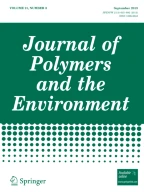Abstract
Chrome tanning generates large amounts of leather wastes (LW) which have become a considerable environmental issue. In this work, particulate LW with and without urea treatment were characterized by Fourier transform infrared spectroscopy (FTIR), scanning electron microscopy (SEM), thermogravimetric analysis (TGA) under inert and oxidative atmospheres, and elemental analysis. Then treated LW (TLW) were incorporated in natural rubber compounds, seeking to find another way of disposal for this type of residue. The effect of TLW on rheometric properties of rubber composites during vulcanization was evaluated, including parameters related to leather particles dispersion in the matrix. It was found that TLW contained chromium and sulfur remaining from tanning, which could affect the properties of rubber compounds. During TGA analysis, oxidation of chromium into LW was increased as an effect of urea treatment. It was observed that TLW improved rubber processability during open two-roll mill mixing process. Rheometric characteristics allowed to identify a decreased TLW particle dispersion into the compound with the increase of its content in the composites. Stiffness of vulcanized composites and the kinetic of the vulcanization varied with TLW content, as an effect of the interaction of TLW with the rubber compound. Particulate leather wastes morphology could facilitate its mechanical interlocking with the polymeric matrix. The development of these type of composites will enable another profitable use for this type of waste.
Similar content being viewed by others
Explore related subjects
Discover the latest articles, news and stories from top researchers in related subjects.Abbreviations
- LW:
-
Untreated leather wastes
- TLW:
-
1% urea treated leather wastes
- TGA:
-
Thermogravimetric analysis
- AAS:
-
Atomic absorption spectrometry
- ODR:
-
Oscillating Disc Rheomether
- ML :
-
Minimum torque at rheometric tests
- ∆M:
-
Increasing in torque at rheometric test as an effect of crosslinking
- t0 :
-
time corresponding to the beginning of vulcanization reaction in rheometric tests
- t100 :
-
Time corresponding to the completation of vulcanization in rheometric tests
- phr:
-
Parts per hundred of rubber
- FTIR:
-
Fourier transform infrared spectroscopy
- ATR:
-
Attenuated total reflectance
- DRX:
-
X-ray diffraction
- SEM:
-
Scanning electron microscopy
- NR:
-
Natural rubber
- MH :
-
Maximum torque at rheometric tests
References
Bacardit A, Baquero G, Sorolla S, Ollé L (2015) Evaluation of a new sustainable continuous system for processing bovine leather. J Clean Prod 101:197–204
Nazer DW, Al-Sa’ed RM, Siebel MA (2006) Reducing the environmental impact of the unhairing–liming process in the leather tanning industry. J Clean Prod 14(1):65–74
Ravichandran K, Natchimuthu N (2005) Natural rubber—leather composites. Polímeros: Ciência E Tecnologia 15:102–108
Garcia NG, dos Reis EAP, Budemberg ER, da Silva Agostini DL, Salmazo LO, Cabrera FC, Job AE (2014) Natural rubber/leather waste composite foam: a new eco-friendly material and recycling approach. J Appl Polym Sci 132(11):1–10
Santos RJ, Agostini DLS, Cabrera FC, Budemberg ER, Job AE (2014) Recycling leather waste: preparing and studying on the microstructure, mechanical, and rheological properties of leather waste/rubber composite. Polym Compos 36(12):1–7
Santos RJ, Agostini DLS, Cabrera FC, Budemberg ER, Job AE (2015) Recycling leather waste: preparing and studying on the microstructure, mechanical, and rheological properties of leather waste/rubber composite. Polym Compos 36(12):2275–2281
Senthil R, Hemalatha T, Manikandan R, Das BN, Sastry TP (2014) Leather boards from buffing dust: a novel perspective. Clean Technol Environ Policy 17(2):571–576
ASTM International (2002) Standard specification for natural rubber (NR) technical grades. pp 1–3
ASTM international (2015) Standard test method for rubber property—vulcanization using oscillating disk cure. pp 1–12
Rafei M, Ghoreishy MHR, Naderi G (2009) Development of an advanced computer simulation technique for the modeling of rubber curing process. Comput Mater Sci 47(2):539–547
Lee BL (1979) Dispersion of fillers in rubber_L parameter_1979_Lee.pdf. Rubber Chem Technol 52(5):1019–1029
Boyatzis SC, Malea E, Kehagia M (2010) Second derivative and peak fitting in FTIR analysis of leather protein: investigation of changes in tanned leather after cleaning
Wiechec A, Opiela J, Lipiec E, Kwiatek WM (2013) Utility of FT-IR imaging spectroscopy in estimating differences between the quality of bovine blastocysts. J Mol Struct 1049:227–232
Seymour-Jones FL (1922) The chemical constituents of skin. J Ind Eng Chem 14(2):130–132
Zhizhin G, Kuptsov AH (1998) Handbook of FTIR and Raman spectra of polymers. Elsevier science publisher, Amsterdam
Yılmaz O, Cem Kantarli I, Yuksel M, Saglam M, Yanik J (2007) Conversion of leather wastes to useful products. Resour Conserv Recycl 49(4):436–448
Ozgunay H, Colak S, Mutlu MM, Akyuz F (2007) Characterization of leather industry wastes 16(6):867–873
Ludvík J (2000) United Nations Industrial Development Organization. In: Chrome management in the tanyard, pp 1–39
Ravichandran K, Natchimuthu N (2005) Vulcanization characteristics and mechanical properties of natural rubber-scrap rubber compositions filled with leather particles. Polym Int 54(3):553–559
Surya I, Ismail H (2016) The effect of the addition of alkanolamide on properties of carbon black-filled natural rubber (SMR-L) compounds cured using various curing systems. Polym Test 50:276–282
Acknowledgements
The authors want to thank the SENNOVA at Sena (the spanish acronym for the National Service of Learning fo Colombia), by its support through the SENNOVA Leaders program.
Author information
Authors and Affiliations
Corresponding author
Rights and permissions
About this article
Cite this article
Cardona, N., Velásquez, S. & Giraldo, D. Characterization of Leather Wastes from Chrome Tanning and its Effect as Filler on the Rheometric Properties of Natural Rubber Compounds. J Polym Environ 25, 1190–1197 (2017). https://doi.org/10.1007/s10924-016-0898-9
Published:
Issue Date:
DOI: https://doi.org/10.1007/s10924-016-0898-9
